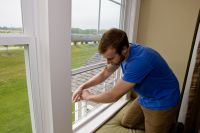Windows are a part of everyday life for children in the United States. While many parents know that windows can be a hazard for their child, they may not be aware just how often things can take a turn for the worse.
A new study conducted by researchers at the Center for Injury Research and Policy of The Research Institute at Nationwide Children’s Hospital found that approximately 5,200 children and adolescents 17years of age and younger were treated in U.S. emergency departments each year from 1990 through 2008 for injuries sustained due to falls from windows. This translates to approximately 14 children being injured as the result of a window fall every day in the U.S.
The study, being released online August 22, 2011 and appearing in the September 2011 print issue of Pediatrics, found that children 0 to 4 years of age were especially vulnerable, not only accounting for a majority (65 percent) of the injures, but also having a higher rate of serious injury resulting in hospitalization or death. Children who fell from a height of 3 stories or above or who landed on a hard surface, such as concrete or brick, were also at increased risk for serious injury. Overall, the most common injuries were to the head and face region (49 percent), and the most frequent injury diagnoses were soft tissue injury (41 percent) and brain/head injury (26 percent).
“Window fall injuries are serious. In fact, one out of every four children in our study was hospitalized as a result of their injury,” said the study’s senior author Gary Smith, MD, DrPH, director of the Center for Injury Research and Policy at Nationwide Children’s Hospital. “We know from successful programs in New York City and Boston [community education programs re: window fall prevention] that child injuries due to falls from windows can be prevented. We need to do a better job of protecting our children from these types of serious injuries.”
In this study, more than190 children fell from windows each year after gaining access to the window by climbing on furniture placed near the window. Therefore, furniture should be moved away from windows to help keep young children safe.
“In addition, it is important for parents to understand that window screens will not prevent a child from falling out of a window,” said Dr. Smith, also a professor of pediatrics at The Ohio State University College of Medicine. “There were many children in our study who pushed a screen out of a window and then fell from the window.”
To prevent injuries from window falls:
- Install window guards on all second-story or higher windows in places where young children live or visit.
- Remember that screens will NOT prevent a child from falling out of a window.
- If windows are open, use window stops to prevent the window from opening more than 4 inches.
- Move all furniture away from windows.
- Remember that fire escapes, roofs and balconies are not safe places for children to play.
- Educate older children on the dangers of climbing out of or jumping from windows.
- Consider planting bushes or locating flower beds under windows to soften the landing surface, which may reduce the severity of injury in the event of a fall.
This is the first study to use a nationally representative sample to examine injuries associated with window falls that were treated in U.S. emergency departments. Data for this study were obtained from the National Electronic Injury Surveillance System (NEISS), which is operated by the U.S. Consumer Product Safety Commission. The NEISS dataset provides information on consumer product-related and sports and recreation-related injuries treated in hospital emergency departments across the country.
The Center for Injury Research and Policy (CIRP) of The Research Institute at Nationwide
Children’s Hospital works globally to reduce injury-related pediatric death and disabilities. With innovative research as its core, CIRP works to continually improve the scientific understanding of the epidemiology, biomechanics, prevention, acute treatment and rehabilitation of injuries. CIRP serves as a pioneer by translating cutting edge injury research into education, policy and advances in clinical care. For related injury prevention materials or to learn more about CIRP visit http://www.injurycenter.org.

Install window guards on all second-story or higher windows in places where young children live or visit

If windows are open, use window stops to prevent the window from opening more than 4 inches
